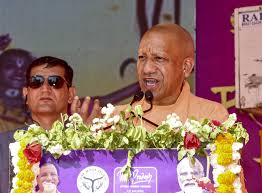At NDA Conclave UP CM Yogi Adityanath Showcases His Govts Achievements
During the National Democratic Alliance (NDA) Chief Ministers’ conclave held in the national capital on Sunday, Uttar Pradesh Chief Minister Yogi Adityanath showcased the transformative accomplishments of Project Alankaar, a flagship initiative undertaken by the state government to revolutionize the condition of government secondary schools.
The high-level meeting, chaired by Prime Minister Narendra Modi, focused on the exchange of innovative governance practices among states. Within this context, Project Alankaar was prominently highlighted as a model of effective and impactful educational reform.
Project Alankaar, officially launched on October 1, 2021, aims to bring about comprehensive changes in the infrastructure and overall learning environment of 2,441 government-run secondary schools across Uttar Pradesh.
The initiative sets out to ensure 100% compliance with 35 defined benchmarks related to school infrastructure and essential facilities.
These benchmarks serve as indicators of quality and modernity in educational settings and are designed to meet both the practical needs and developmental aspirations of students and teachers.
As part of this ambitious project, a wide range of improvements have been carried out in schools. These include the construction of new and modern classrooms, the establishment of well-equipped science laboratories, the development of libraries, the installation of computer laboratories, and the integration of smart classrooms.
In addition, essential amenities such as access to clean drinking water, sanitary and hygienic toilets, and gender-inclusive facilities have also been ensured.
Together, these interventions are creating a more conducive, inclusive, and engaging environment for students to thrive academically and socially.
One of the distinguishing features of Project Alankaar is its multi-source funding model.
The financial resources required for the implementation of the project are drawn from a variety of sources, including direct funding from the Uttar Pradesh state government, contributions under the Samagra Shiksha Abhiyan, assistance from gram panchayats and urban local bodies, as well as support from corporate social responsibility (CSR) initiatives and voluntary donations from individuals and organizations.
This collaborative funding approach has not only diversified the financial base of the project but also fostered a sense of collective responsibility and community ownership.
The implementation and monitoring of Project Alankaar follow a decentralized yet rigorous framework. District-level committees, chaired by the respective District Magistrates, are responsible for ensuring on-ground execution, while the overall supervision at the state level is entrusted to the Director of Education.
This layered governance structure ensures transparency, accountability, and timely progress monitoring.
The success of Project Alankaar has also been recognized in independent assessments. According to the Annual Status of Education Report (ASER) 2024, the initiative has had a measurable impact on student engagement and participation.
The report notes that the enhanced infrastructure and improved learning conditions have played a significant role in encouraging children to attend school regularly and take an active interest in their studies.
Statistical data shared by the state government further underscores the positive outcomes of the initiative. Between the academic sessions of 2022-23 and 2024-25, enrollment in government secondary schools witnessed a notable increase of 23%, indicating a growing trust among families in the public education system.
In addition, library usage among students surged by 55.2%, reflecting a renewed emphasis on reading and self-directed learning. Importantly, access to toilet facilities for girls improved by 54.4%, signaling progress toward gender-sensitive infrastructure and promoting better school attendance among female students.
Through Project Alankaar, the Uttar Pradesh government has made a concerted effort to bridge infrastructural gaps, promote equity in education, and create a learning environment that meets the needs of the 21st century.
The project is now being seen not only as a state-level success story but also as a replicable model for educational transformation at the national level.

